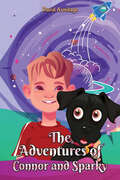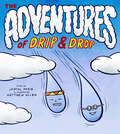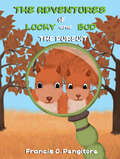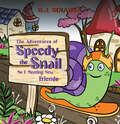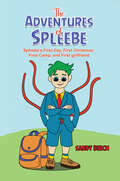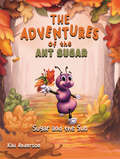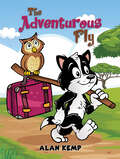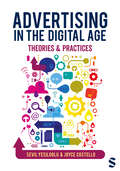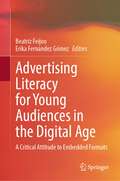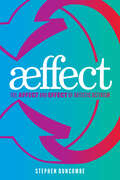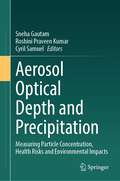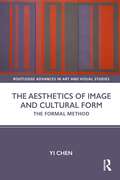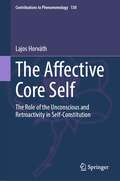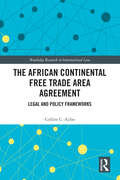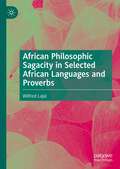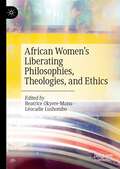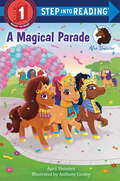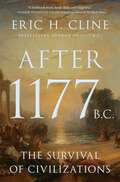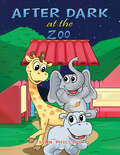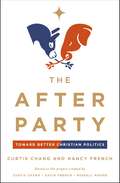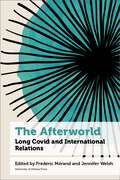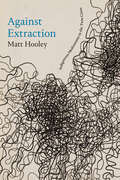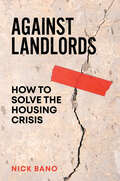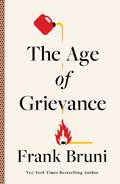- Table View
- List View
The Adventures of Connor and Sparky
by David ArmitageDreams can be anything you want them to be, but imagine flying through space doing cartwheels, flying past a giant floating doggy biscuit, or realizing that planet Mars, was in fact a giant chocolate bar. But this is just part of the story. Connor used to be such a happy little boy, but world events had made him sad and confused. Despite the best efforts of his mum and dad, and all the people who loved him, to cheer him up, nothing seemed to work. A new plan was needed, but would it work? It didn’t take long for Connor and his new dog, Sparky, to become the best of friends. At night-time, sleeping soundly, the pair would begin to have the wildest of adventures together. Join them on their first as they race aliens around Saturn and try to beat the current intergalactic champion. Starting from the back, the dynamic duo would need all their skills, determination, and resilience, to cross the ‘Slime Line’ first, but could they, do it?
The Adventures of Drip and Drop
by Jaimal YogisBeloved children&’s book authors Jaimal Yogis and Matthew Allen are back with a new children&’s book about how mindfulness begins with a leap of faith to feel alive againDrip and Drop are just a couple of care-free clouds floating on the breeze. But when Sky Dive Day hits, they're forced to discover what they're really made of (and yes, their names are a hint). Join Drip and Drop on this hilarious and heartwarming adventure as they struggle to embrace change, face their fears, and open their hearts while also getting a first-hand crash course in the water cycle.
The Adventures of Lucky and Bud: The Pursuit
by Francis C. PengitoreThis sequel to The Adventures of Lucky and Bud: The Rescue finds the boys at the center of a mystery when their chipmunk cousins&’ winter food cache is robbed, and the mischievous pair, who have a reputation for raiding bird feeders, eating flower bulbs, and stealing corn cobs and tomatoes from Mr. Pickles&’ vegetable garden, become suspects. To clear their names, find the real thief and, hopefully, recover the stolen food, they lead a search with help from their friends and other animals in their neighborhood to hunt for clues in what turns out to be a thrilling and, at times, risky, pursuit.Along the way, the amateur detectives learn about the importance of friendship and loyalty, as well as the problems that can arise from prejudging others without knowing all the facts or shunning those who look different or come from unfamiliar places.
The Adventures of Speedy the Snail: No 1: Meeting New Friends
by B. J. SinagraSpeedy the Snail goes an exciting adventure when he stops to help his good friend Lucy Ladybug. Together they meet Sammy the Spider who, at first, appears a frightening and imposing figure! But taking a chance and showing some kindness, the three soon become good friends.
The Adventures of Spleebe: Spleebe’s First Day, First Christmas. First Camp, and First girlfriend
by Sandy BeechIt’s the year 2040, and thanks to astonishing advances in space exploration technology, humans have made first contact with a variety of astonishing alien civilizations. United in an intergalactic coalition called the Unified Federation of Galaxies, Earthlings now have access to the profound wisdom of far more advanced beings from across the cosmos. As interplanetary travel and immigration become commonplace, the Sprantle family moves from their homeworld to Melbourne, Australia when Mr. Blaptet Sprantle accepts a position with the Australian Space Agency. For young Spleebe Sprantle and his sister Pweedle, fitting in with the earthlings poses an unexpected challenge, as the sibling aliens struggle to align their eccentric appearances and mannerisms to blend into this utterly foreign society. Eager to assimilate, the well-meaning extraterrestrial newcomers soon discover that being accepted is far more easily said than done. In his fish-out-of-water quest to be understood, precocious young Spleebe learns that even across galaxies, the things that make you different are often the very things that make you stand out. Overflowing with humour and heart, The Adventures of Spleebe is an out-of-this-world coming-of-age tale about embracing your uniqueness while navigating the winding roads that lead to belonging. As Spleebe forges unlikely friendships with his new human pals, he shows Earth’s children that being an alien on the inside is something to celebrate.
The Adventures of the Ant Sugar: Sugar And The Sun
by Kiki AndersonDo you want to know where the sun is hiding? Do you know what the sun is and how many suns there are? Sugar Ant didn’t know either, but with the help of his new friends, he soon found the answers. Things are sometimes quite simple, and we don’t have to look to the ends of the earth to find them because they are very close to us! Another tale of Ant Sugar will take you to exciting new adventures, and will make you experience together with him the unexpected revelations about the sun.
The Adventurous Fly
by Alan KempThe Adventurous Fly tells the heartwarming tale of Fly, a stray border collie embarking on an exciting journey that will resonate with children and parents alike. As the endearing central character, Fly models the enduring importance of kindness and friendship in a delightful way that captures the imagination. Readers are sure to be entertained following Fly’s amusing adventures, facing life’s little challenges with energetic optimism. At the same time, they will learn timeless lessons about compassion as Fly lives out the loyalty and affection border collies are so beloved for. The story provides the perfect opportunity for families to cozy up together and become wrapped up in the page-turning exploits of this memorable canine hero that both kids and adults will adore.
Advertising in the Digital Age: Theories and Practices
by Sevil Yesiloglu Joyce CostelloAdvertising is everywhere. Whether you realise it or not, it′s there when you watch your favourite Netflix show, when you scroll through Instagram, and when you search on Google. What′s more, advertisers are becoming more savvy than ever, using new technologies to target adverts to you specifically. So what are we to make of all this? This book will equip you with a thorough understanding of today′s media environment and how ′online′ advertising differs from traditional ′offline′ models. In an age of influencers, big data, AI and social media, the world of advertising looks very different from how it did a generation ago. You will learn not only about various types of advertising, but also about its impact on viewers, from our buying habits to possible harm. Tying theory and concepts to practice, this volume is the ideal complement to courses in advertising, digital media and communication, and will enable you to form a clear picture of the reality of working across promotional media industries.
Advertising in the Digital Age: Theories and Practices
by Sevil Yesiloglu Joyce CostelloAdvertising is everywhere. Whether you realise it or not, it′s there when you watch your favourite Netflix show, when you scroll through Instagram, and when you search on Google. What′s more, advertisers are becoming more savvy than ever, using new technologies to target adverts to you specifically. So what are we to make of all this? This book will equip you with a thorough understanding of today′s media environment and how ′online′ advertising differs from traditional ′offline′ models. In an age of influencers, big data, AI and social media, the world of advertising looks very different from how it did a generation ago. You will learn not only about various types of advertising, but also about its impact on viewers, from our buying habits to possible harm. Tying theory and concepts to practice, this volume is the ideal complement to courses in advertising, digital media and communication, and will enable you to form a clear picture of the reality of working across promotional media industries.
Advertising Literacy for Young Audiences in the Digital Age: A Critical Attitude to Embedded Formats
by Beatriz Feijoo Erika Fernández GómezThis book analyzes how children and adolescents aged between 10 and 17 engage with digital advertising and highlights the importance of promoting advertising literacy to help young audiences recognize advertising and distinguish it from other media content in the digital age. As the advertising sector evolves, incorporating new formats like branded content and influencer marketing, the frontiers between commercial content and regular media become blurred, posing a challenge for children and adolescents to discern persuasive intent in advertising and distinguish advertising from other media content. In this context, it is crucial to assess children and adolescents’ preparedness to navigate digital advertising effectively by understanding their level of advertising literacy. With a higher level of advertising literacy, young audiences can evaluate advertisements, considering factors such as product appeal, presentation, and relevance to their experiences, as well as grasp thepurpose behind advertising and the techniques employed. This contributed volume brings together empirical studies and literature reviews to present an overview of the current research on advertising literacy among boys and girls aged between 10 and 17 in different countries to help educators, policymakers, advertisers, and society at large collaborate in nurturing responsible, informed, and ethically conscious digital citizens. Advertising Literacy for Young Audiences in the Digital Age: A Critical Attitude to Embedded Formats will be of interest to researchers working with media education, media sociology and childhood and adolescence studies. It will also help educators and policymakers develop better strategies to prepare children and adolescents to navigate digital advertising effectively.
Aeffect: The Affect and Effect of Artistic Activism
by Stephen DuncombeThe first book to seriously identify how artistic activism works and how to make it work betterThe past decade has seen an explosion in the hybrid practice of “artistic activism,” as artists have turned toward activism to make their work more socially impactful and activists have adopted techniques and perspectives from the arts to make their interventions more creative. Yet questions haunt the practice: Does artistic activism work aesthetically? Does it work politically? And what does “working” even mean when one combines art and activism? In Æffect, author Stephen Duncombe sets out to address these questions at the heart of the field of artistic activism.Written by the co-founder and current Research Director of the internationally recognized Center for Artistic Activism, Æffect draws on Duncombe’s more than twenty-five years of experience in the field and one hundred in-depth interviews with artistic activists worldwide. More than a mere academic exercise, the theory, research, and tools in this book lay the groundwork for artistic activists to evaluate and strengthen their practice and to create better projects. The exploration of good artistic activism is grounded in three sets of concerns. 1) Change: Upon what theories of change is artistic activism based? 2) Intention: What do we hope and expect artistic activism to do, and how does it do this? 3) Evaluation: What actually happens as the result of an artistic activist intervention? Can it be measured?Æffect is rich with examples that demonstrate successful artistic activism, including Undocubus, an old bus painted “No Fear” across its side that was driven cross-country by a group of undocumented immigrant activists; Journal Rappé, a video show created by Senegalese rappers who created long-form investigative reports by rapping the current news in French and Wolof; and War on Smog, a staged a public performance piece by artistic activists in the city of Chongqing in Southwest China. Scannable QR codes are included to provide tools that help readers assess the æffect of their artistic activism.
Aerosol Optical Depth and Precipitation: Measuring Particle Concentration, Health Risks and Environmental Impacts
by Sneha Gautam Cyril Samuel Roshini Praveen KumarThis volume uses aerosol optical depth (AOD) analysis through mapping and remote sensing techniques to derive the relationship between aerosols and hazardous precipitation events, primarily in the form of flooding. Attention is also given to pollution caused by an abundance of particulate matter in the atmosphere and its impacts on human health, which is also assessed via the study of AOD. Background is given on how AOD is retrieved, and why it is a useful tool for estimating atmospheric particle concentration, but also the challenges associated with using this approach. Different aerosol types are introduced to perform a comparative analysis of the most common associations between pollution impacts on temperature and resulting precipitation events. These analyses will help to provide an overview of the best strategies to make informed and sustainable disaster risk management practices and policies. The target audience for the work is students, researchers, and scientists working witha vision towards sustainability, public health safety and air pollution mitigation measures. It will also be a useful text for climate change policy makers, environmental engineers and stakeholders in social development sectors.
The Aesthetics of Image and Cultural Form: The Formal Method (Routledge Advances in Art and Visual Studies)
by Yi ChenOffering an alternative mode of visual cultural analysis to the prevalent discursive model, this book proposes to situate analysis of Image within ‘formal’ analyses of culture experience.Specifically, the discussion draws on theories of affective aesthetics with the view of addressing the sensual form of culture (i.e. ‘cultural form’). Therefore, the volume puts forward a mode of formalist analysis in visual cultural research which takes purchase on the idea of ‘cultural form’. A continuum of formalist attention between Image analysis (visual media, industrial design) and probing of ‘cultural forms’ establishes the theoretical underpinning of the book. These concepts are expounded through a case study which looks at formal experimentations and debates arising from 1960s avant-garde artistic practices in London.
The Affective Core Self: The Role of the Unconscious and Retroactivity in Self-Constitution (Contributions to Phenomenology #130)
by Lajos HorváthThis book extends the contemporary concept of the minimal self by introducing the affective core self. The overall aim is to integrate certain psychoanalytical ideas into the phenomenological investigation of passivity and reformulate the idea of the phenomenological unconscious. This volume contributes to the multidimensional analysis of the self by positioning the affective core self between the layers of the more minimal and the less minimal self. It underscores the importance of the unconscious in the constitution of the affective core self by providing the comparative analysis of the phenomenological and the psychoanalytical unconscious.Furthermore, comparisons are drawn between Freud’s conception of the afterwardsness of trauma and the phenomenological notion of retroactive sense-constitution. The book concludes that retroactive sense-making is a double-sided phenomenon and differentiates between implicit-bodily and conscious-narrative retroactive sense-constitution. In order to bolster the idea of implicit-bodily sense-constitution the volume also examines and utilizes contemporary insights on the nature of body memory. The conclusion claims that the affective core self is constituted in time by means of the underlying processes of the two-sided retroactive sense-constitution. This text appeals to students and researchers working in phenomenology and philosophy of mind.
The African Continental Free Trade Area Agreement: Legal and Policy Frameworks (Routledge Research in International Law)
by Collins C. AjiboThis book provides a comprehensive assessment of African economic integration through the lens of International Economic Law. The analysis is contextualised within the prevailing regional economic integrations, the WTO and the peculiarity of the AfCFTA.Through legal analysis, bolstered by economic and political dimensions, the book illustrates the complex interplay of diverse factors that shape the AfCFTA. Each chapter presents a separate element of economic integration within the principles of international economic law, with an interdisciplinary approach encompassing legal, economic and political perspectives. Covering topics such as economic integration and multilateralism, market access, exceptions, trade facilitation, rules of origin and non-tariff barriers, the book also discusses trade remedies, dispute settlement, investment, intellectual property and completion policy. Additionally, human rights, corporate social responsibility and sustainable development principles are discussed, alongside small and medium-sized enterprises (SMEs), digital trade and gender in economic integration.The book will be of interest to students, instructors, practitioners and nonpractitioners in this area of international economic law.
African Philosophic Sagacity in Selected African Languages and Proverbs
by Wilfred LajulThis book explores African philosophic sagacity, or wisdom philosophy, as proposed by Odera Oruka in his “Four Trends in Current African Philosophy” (1981), which he later expanded to six trends (1998). Oruka defines philosophic sagacity as wisdom philosophy, or philosophy of the wise men of Africa who are independent, liberal and non-conformist thinkers, and who often deviate from the accepted common norms of their societies. This book takes philosophic sagacity discourse beyond Oruka’s definition by encompassing traditional wise sayings and proverbs. It combines individual liberal thinkers and the communal ideas, and cherishes both rational and emotional engagement, offering a broader understanding of African philosophic sagacity. Wilfred Lajul opens the door for new researchers to venture into the study of African languages, wisdom sayings, and proverbs, and helps to unveil the content of this philosophy from the perspective of different African societies.
African Women’s Liberating Philosophies, Theologies, and Ethics
by Beatrice Okyere-Manu Léocadie LushomboThis volume explores the ethical and philosophical paradigms presented by most of the influential Matriarchs of the Circle of African Women Theologians. It critically evaluates the effectiveness of their ethical and philosophical theories, models, and frameworks in pursuing justice and liberation for women in Africa and globally. The authors address critical questions: How have African women theologians reimagined existing ethical paradigms? What original ethical and philosophical ideas have they generated? How have their ethical frameworks influenced the theologies and interpretations they have developed? What purposes do their ethical and philosophical paradigms serve? How do these renderings intersect with various social categories, including gender, race, class, sexuality, capitalism, and colonialism? What liberating frameworks do they propose? The volume further explores the dialogue between distinct African contexts and universal experiences and values. It explores how universal themes such as humanity, human dignity, rights, justice, motherhood, and more can coexist with communal African concepts and themes. It contemplates how embracing African approaches engages these themes more globally, bringing together particular African contexts of women and the universal ethical, philosophical, and theological theories, models, and frameworks to advance the cause of justice and liberation for African women and women worldwide into the future.
Afro Unicorn: A Magical Parade (Step into Reading)
by April ShowersThe Afro Unicorns are on parade! Magical, Unique, and Divine celebrate inclusivity and friendship as they bring all the Afro Unicorns together to celebrate the annual Festival of Crowns.The Festival of Crowns is one of the biggest gatherings of the year in Afronia, and everyone is excited to march in the big parade to celebrate.But when a last-minute problem puts the parade in jeopardy, the three best friends work together to find a solution. When Afro Unicorn creator April Showers realized that her favorite emoji—the unicorn!—was only available in white, she was inspired to create a more inclusive brand for children of color to celebrate how magical, unique, and divine they truly are. Don&’t miss the other books in the Afro Unicorn series—The Most Magical Time of the Year!Divine Makes a SplashWe Are Afro UnicornsYou Are a Unicorn! A Magical DayStep 1 Readers feature big type and easy words for children who know the alphabet and are eager to begin reading. Rhyme and rhythmic text paired picture clues help children decode the story.
After 1177 B.C.: The Survival of Civilizations (Turning Points in Ancient History #12)
by Eric H. ClineIn this gripping sequel to his bestselling 1177 B.C., Eric Cline tells the story of what happened after the Bronze Age collapsed—why some civilizations endured, why some gave way to new ones, and why some disappeared forever&“A landmark book: lucid, deep, and insightful. . . . You cannot understand human civilization and self-organization without studying what happened on, before, and after 1177 B.C.&”—Nassim Nicholas Taleb, bestselling author of The Black SwanAt the end of the acclaimed history 1177 B.C., many of the Late Bronze Age civilizations of the Aegean and Eastern Mediterranean lay in ruins, undone by invasion, revolt, natural disasters, famine, and the demise of international trade. An interconnected world that had boasted major empires and societies, relative peace, robust commerce, and monumental architecture was lost and the so-called First Dark Age had begun. Now, in After 1177 B.C., Eric Cline tells the compelling story of what happened next, over four centuries, across the Aegean and Eastern Mediterranean world. It is a story of resilience, transformation, and success, as well as failures, in an age of chaos and reconfiguration.After 1177 B.C. tells how the collapse of powerful Late Bronze Age civilizations created new circumstances to which people and societies had to adapt. Those that failed to adjust disappeared from the world stage, while others transformed themselves, resulting in a new world order that included Phoenicians, Philistines, Israelites, Neo-Hittites, Neo-Assyrians, and Neo-Babylonians. Taking the story up to the resurgence of Greece marked by the first Olympic Games in 776 B.C., the book also describes how world-changing innovations such as the use of iron and the alphabet emerged amid the chaos.Filled with lessons for today's world about why some societies survive massive shocks while others do not, After 1177 B.C. reveals why this period, far from being the First Dark Age, was a new age with new inventions and new opportunities.
After Dark at the Zoo
by Siân PhillipsAs night falls on the zoo and the gates close behind the last visitor, a world of adventure stirs to life. Herbert, a keen-eyed inhabitant, quickly discovers the unlocked enclosures. Driven by curiosity, he ventures out, inviting fellow animals like Geoffrey and Ernie to join him. Together, they embark on a delightful exploration of their home after dark. After Dark at the Zoo is a heartwarming tale of friendship and discovery, inviting readers to follow Herbert and his companions on their nocturnal journey, full of sincerity and playful escapades.
The After Party: Toward Better Christian Politics
by Curtis Chang Nancy FrenchFor the exhausted, the hurting, and the faithful, The After Party helps reframe our political identity away from the "what" of political positions and toward the "how" being centered on Jesus.This paradigm-shifting book complements The After Party Project--a six-part, video-based, highly interactive curriculum that provides churches, small groups, and individuals with an on-the-ground, biblically based approach to a very complex topic.The After Party: Toward Better Christian Politics helps readers who feel despair about political divisiveness:Engage with others across political differencesLearn specific steps to reframe political identity outside of partisan dividesFocus on how we relate to one another as Jesus teaches before moving to the what of political topicsThe After Party is ideal for:Republicans, Democrats, and Independents looking for renewed hope and humility for our nationLocal leaders seeking to counter animosity toward political opponents, susceptibility to lies, and other practices that threaten the common goodCongregations, classes, and small groups watching The After Party video seriesPastors who want to encourage their congregants to trade their partisan mindsets for the mind of ChristIt's not too late. In today's political environment, faithfulness to a biblical how of political engagement shines as a radical challenge to both the Right and the Left. If you worry about what politics is doing to your community, your family, and your own well-being, The After Party will transform your political imagination.It's time for us to go beyond party politics and--as Christians--believe in the true "party" yet to come.
The Afterworld: Long COVID and International Relations (Health and Society)
by Anthony Amicelle Valérie Amiraux Vincent Arel-Bundock Ari Van Assche Daniel Béland Karim Benyekhlef Mark R. Brawley Dominique Caouette Allison Christians Ryoa Chung François Crépeau Pierre-Marie David Magdalena Dembińska Peter Dietsch Thomas Druetz Pearl Eliadis Philippe Fournier François Furstenberg Pablo Gilabert Timothy Hodges Maya Jegen Juliet Johnson Nicholas King Erick Lachapelle Justin Leroux Pierre Martin Sarah-Myriam Martin-Brûlé María Martín Iniesta Erik Martinez Kuhonta Theodore McLauchlin Frédéric Mégret Cynthia Milton Laurence Monnais Christian Novak Mme Mireille Paquet T. V. Paul Krzysztof Pelc Pierre-Olivier Pineau Vincent Pouliot René Provost Lee Seymour Thomas Soehl Maïka Sondarjee Samuel Tanner Jean-Philippe Thérien Hamish Van Ven Luna Vives Marie-Joëlle Zahar Alain GagnonLa COVID-19 a provoqué la crise mondiale la plus importante et la plus globale du 21e siècle. Pour certains, les répercussions ont été rapides et dramatiques, la pandémie poussant des dizaines de millions de personnes dans la pauvreté et générant une insécurité alimentaire extrême. Pour d’autres, les transformations bouillonnent encore sous la surface et des questions demeurent quant à savoir si les changements de société induits par la COVID-19 perdureront dans la période post-pandémique. Le retour de la géopolitique, avec la guerre en Ukraine et les tensions en Asie, complexifie le portrait mondial.Depuis mars 2020, on a vu une explosion d'analyses à propos de l'impact à court terme et des conséquences futures de la « longue COVID » sur les relations internationales. On a rapidement établi des parallèles établis avec l’effondrement de l'Europe des années 1930, raconté par Stefan Zweig dans ses célèbres mémoires, Le monde d’hier. Alors que la plupart des commentateurs font preuve de pessimisme, certains cherchent des lueurs de changement positif. Cette crise sans précédent exige de réfléchir à la manière dont, dans le « monde d’après », nous pouvons travailler à améliorer l'économie, la justice sociale, l'environnement, les relations entre les sexes, la santé et les institutions politiques - ou, à tout le moins, à faire en sorte qu'elles ne se détériorent pas davantage.Dans ce livre, 50 professeurs des quatre universités montréalaises, parmi les meilleurs experts de leur domaine, braquent le projecteur sur un défi spécifique : celui des relations internationales. À partir de leurs analyses, ils proposent des idées progressistes, pragmatiques et fondées sur les sciences sociales qui pourraient améliorer la coopération internationale, la sécurité et la prospérité durable après la fin de la pandémie.Note : Ce livre est publié en anglais aux Presses de l'Université d'Ottawa. La version originale de l'ouvrage est disponible aux Presses de l'Université de Montréal.
Against Extraction: Indigenous Modernism in the Twin Cities
by Matt HooleyIn Against Extraction Matt Hooley traces a modern tradition of Ojibwe invention in Minneapolis and St. Paul from the mid-nineteenth century to the present as that tradition emerges in response to the cultural legacies of US colonialism. Hooley shows how Indigenous literary and visual art modernisms challenge the strictures of everyday life and question the ecological, political, and cultural fantasies that make multivalent US colonialism seem inevitable. Hooley analyzes literature and art by Louise Erdrich, William Whipple Warren, David Treuer, George Morrison, and Gerald Vizenor in relation to histories of Indigenous dispossession and occupation, enslavement and Black life, and environmental harm and care. He shows that historical narratives of these cities are intimately bound up with the violence of colonial systems of extraction and that concepts like Indigeneity and sovereignty extend beyond treaty-granted promises of political control. These works, created in opposition and proximity to the extraction of cultural, political, and territorial resources, demonstrate how Indigenous claims to life and land matter to rethinking and unmaking the social and ecological devastations of the colonial world.
Against Landlords: How to Solve the Housing Crisis
by Nick BanoWhen landlords always win and renters pay the price, what can be done?Housing means prosperity and security for some; poverty, precarity and sickness for others. More people live in private rented accommodation than ever before, and rents rise without apparent reason. Homes are smaller every year, and nearly 20 per cent of tenants live in hazardous conditions. Homelessness is at a new high. Yet the government&’s only solution is to promote homeownership.Against Landlords shows that this crisis is not the product of happenstance or political incompetence. Government policy has intentionally split British citizens into homeowners and renters, two classes set on very different financial paths. In the UK, one out of every twenty-one adults is a landlord, and it is this group, and those who aspire to join it, represented by the political class.In his radical new interpretation of the housing crisis, lawyer Nick Bano explains how this environment set the conditions for the Grenfell Tower fire and how it means a life of anxiety for the nation&’s renters. It is a problem that stretches far beyond London and one inherently racist in nature.Building more housing is not the solution. It is firstly a problem of the law, Bano argues, and reforms must sweep away the landlordism at the heart of the housing crisis and British political life.
The Age of Grievance
by Frank BruniThe twists and turns of American politics today have become nearly impossible to predict, but the tone is a troubling given. It's one of grievance. A perilous share of Americans across the full breadth of the political spectrum respond to every big disappointment, every little frustration, every way in which the world doesn't hew precisely to their liking by deciding that they've been wronged, identifying the people responsible for that and raging at the injustice of it all. The blame game is the country's most popular sport and victimhood its most fashionable garb. <P><P> Grievance isn't always and necessarily bad. It has often done enormous good. The United States is a nation born of grievance, in the revolt of royal subjects unwilling to accept a bad deal, and across the nearly 250 years of our existence as a country, grievance has been the engine of morally urgent change. But what happens when all sorts of grievances—the greater ones, the lesser ones, the authentic, the invented—are jumbled together? When grievances become all-encompassing lenses, all-purpose reflexes, default settings? When people take their grievances to extreme and even violent lengths that they didn't before? <P><P> A violent mob storms the US Capitol, rejecting the results of a presidential election and embracing the fiction that it was rigged. Conspiracy theories flourish. Politicians appeal not to our better angels but to our worst impulses, encouraging selfishness instead of selflessness, trading inspiration for retribution. Fox News, the country's most watched cable news network, and Tucker Carlson, its sneering star, knowingly peddle lies in the service of profit. The Supreme Court loses touch with the country, overturning Roe v. Wade and shrugging off Clarence Thomas's transgressions. College students chase away speakers and college administrators dismiss instructors for dissenting from progressive orthodoxy. Will Smith slaps Chris Rock. And there's a potentially devastating erosion of the civility, common ground and compromise necessary for our democracy to survive. <P><P> How did we get here? What does it say about us, and where does it leave us? Timely, important, and enlightening, The Age of Grievance examines these critical questions and charts a path forward for a nation that may be growing tired of outrage. <p> <b>New York Times Bestseller</b>
